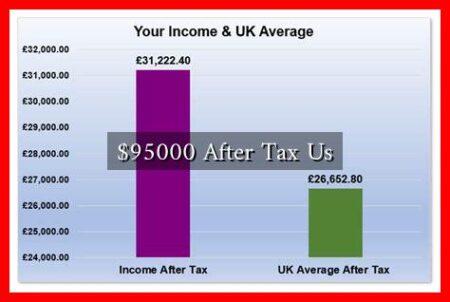-
Table of Contents
Understanding $93,000 After Tax in the U.S.: A Comprehensive Guide
In today’s economic landscape, understanding your take-home pay is crucial for effective financial planning. For many, a salary of $93,000 may seem substantial, but the reality of taxes can significantly impact how much money you actually take home. This article delves into the implications of earning $93,000 after tax in the United States, exploring tax brackets, deductions, and practical financial strategies.
The Tax Landscape in the U.S.
The U.S. tax system is progressive, meaning that as your income increases, so does the rate at which you are taxed. For the tax year 2023, the federal income tax brackets are as follows:
- 10% on income up to $11,000
- 12% on income over $11,000 to $44,725
- 22% on income over $44,725 to $95,375
- 24% on income over $95,375 to $182,100
- 32% on income over $182,100 to $231,250
- 35% on income over $231,250 to $578,125
- 37% on income over $578,125
For someone earning $93,000, the effective tax rate will be lower than the highest bracket they fall into. This is due to the progressive nature of the tax system, where only the income above each threshold is taxed at the higher rate.
Calculating After-Tax Income
To understand how much of a $93,000 salary you actually take home, it’s essential to consider both federal and state taxes. Here’s a simplified breakdown:
- Federal Income Tax: Based on the brackets, a rough estimate of federal tax liability for a single filer earning $93,000 would be approximately $15,000.
- State Income Tax: This varies significantly by state. For example, California has a progressive tax rate that could take around $4,000 from your income, while states like Texas have no state income tax.
- Social Security and Medicare: These payroll taxes typically amount to about 7.65% of your income, which would be around $7,100 for a $93,000 salary.
After accounting for these deductions, a rough estimate of take-home pay would be:
Take-Home Pay = Gross Income – Federal Tax – State Tax – Payroll Taxes
Using the above estimates, a single filer in California might take home around $66,900, while someone in Texas could see closer to $71,100.
Financial Planning with $93,000 After Tax
With a clearer understanding of after-tax income, it’s essential to consider how to allocate this money effectively. Here are some strategies:
- Budgeting: Create a budget that allocates funds for necessities, savings, and discretionary spending. The 50/30/20 rule is a popular method where 50% goes to needs, 30% to wants, and 20% to savings.
- Emergency Fund: Aim to save at least three to six months’ worth of living expenses in an easily accessible account.
- Retirement Savings: Contribute to retirement accounts like a 401(k) or IRA. If your employer offers a match, contribute enough to get the full match as it’s essentially free money.
- Investing: Consider investing in stocks, bonds, or real estate to grow your wealth over time.
Case Study: Real-Life Implications
Consider the case of John, a 30-year-old software engineer living in California. Earning $93,000 annually, John faces significant tax deductions. After calculating his take-home pay, he realizes he has about $66,900 left for the year. Here’s how he allocates his income:
- Housing: $2,000/month ($24,000/year)
- Utilities and Groceries: $500/month ($6,000/year)
- Transportation: $300/month ($3,600/year)
- Discretionary Spending: $400/month ($4,800/year)
- Savings and Investments: $29,500/year
By budgeting wisely, John not only covers his expenses but also sets aside a significant amount for savings and investments.
Conclusion
Understanding the implications of a $93,000 salary after tax is essential for effective financial planning. By grasping the tax landscape, calculating after-tax income, and implementing sound financial strategies, individuals can maximize their take-home pay and secure their financial future. Whether you’re just starting your career or looking to optimize your finances, being informed about your income and taxes is a vital step toward achieving your financial goals.
For more information on tax brackets and financial planning, visit the IRS website.


